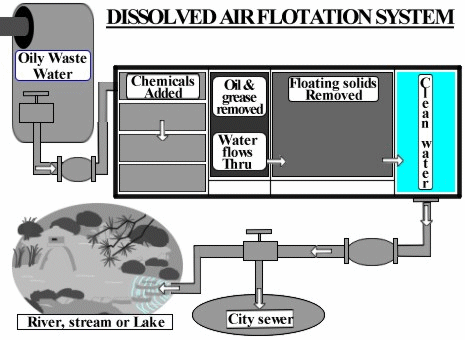Dissolved Air Floatation System

General Advantanges
Recovers Valuable Materials; such as fats, greases, oils, latex, pulp and paper fibers, heat and water for re-use.
Low Capital Investment due to the compact size, flexibility of location and nominal floor space requirements.
Simple Operation and Maintance, requires little attention, offers stable effective operation, fast fill and reduces wash-up volume.
Practical for On Spot Treatment of individual waste streams and their point of origin.
Versatile Process produces a treated water high in dissolved oxygen and suitable for re-use or direct-to-stream disposal without further aeration.
Dissolved aif flotation is a very practical technique for separating suspended particles and colloidal materials from liquids in general and from industrial waste streams in particular. By attaching air bubbles to the suspended particles until there combined net specific gravity becomes less than that of water, the particles are made buoyant. These buoyant particles then rise quickly to the surface forming a "float" which can be removed by skimming. This separated solid material is available for re-use or disposal. Clarified effluent is generally acceptable for safe disposal, return to process or for other plant uses.
To Produce the microscopic air bubbles required for effective floatation, the liquid is presurized, and air is introduced until the liquid approaches saturation. For example, at 50 pounds about five times more air can be dissolved in water than at atmospheric pressure. Subsequently, when pressure is released the liquid becomes supersaturated and the volume of air in excess of the atmospheric saturation concentration comes out of solution in the form of microscopic bubbles. These bubbles may range in size from one hundred and twenty microns, depending on factors such as the type of release, pressure, presence of chemicals, ect.
Most of the bubbles become attached to the solid particles by surface energies while others become entrapped by the solids or by the hydrous oxide flocs.
Particles of colloidal nature are normally too small to permit the formation of a satisfactory air-particle bond. They must first be coagulated by a chemical such as by a chemical such as an aluminum or iron compound and then absorbed by the hydrous metal oxide floc generated by these compounds. Frequently, a cougulant aid is used to agglomerate the hydrous oxide flocs, to enhance particle size and promote the rate of flotation.
